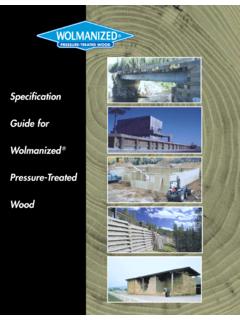Transcription of Material Safety Data Sheet - American Pole and …
1 Material Safety data Sheet Material Name: CCA Type C Pressure-Treated Wood ID: CSI-048 _____ Page 1 of 9 Issue Date: 03/15/04 Revision: Print Date: 6/2/2004 * * * Section 1 - Chemical Product and Company Identification * * * Product Use: Lumber Synonyms: Pressure treated wood with Chromated Copper Arsenate Manufacturer Information Chemical Specialties, Inc. Phone: 704-455-4171 PO Box 1330 Fax: 704-455-6507 5910 Pharr Mill Road Emergency # CHEMTREC: (800) 424-9300 Harrisburg, NC 28075 General Comments NOTE: Emergency telephone numbers are to be used only in the event of chemical emergencies involving a spill, leak, fire, exposure, or accident involving chemicals.
2 All non-emergency questions should be directed to customer service. * * * Section 2 - Composition / Information on Ingredients * * * CAS # Component Percent Not Available Wood/Wood dust 1333-82-0 Chromium (VI) trioxide (CrO3) ; 7778-39-4 Arsenic acid ; 1317-38-0 Copper oxide ; Component Related Regulatory Information This product may be regulated, have exposure limits or other information identified as the following: Wood dust, all soft and hard woods, Wood dusts-soft woods, Wood dusts-hard wood, Chromium (7440-47-3), Chromium (VI) (18540-29-9), Chromium (VI) compounds, Arsenic (7440-38-2), Arsenic, inorganic compounds, Copper(+1) oxide (1317-39-1), Copper compounds, , Copper dusts and mists.
3 Component Information/Information on Non-Hazardous Components CCA Type C Pressure Treated Wood products are made up of >90% "wood" and <10% CCA Type C 50%-60% EPA registered wood preservatives; EPA Registration No.: 10465-26 (CCA50%), 10465-28 (CCA60%) EPA Est. No.: 10465-NC-2, 10356-GA-1, 10365-TX-1 This product is considered hazardous under the criteria specified in 29 CFR (Hazard Communication Standard) and considered a controlled product under the Canadian Workplace Hazardous Materials Information System (WHMIS). The above percentage ranges are in compliance with the Canadian Workplace Hazardous Information System (WHMIS).
4 * * * Section 3 - Hazards Identification * * * Emergency Overview WARNING CANCER HAZARD Product dust may form explosive mixture with air. Product dusts may cause irritation to the eyes, skin and respiratory tract. Product contains a known sensitizing agent. Potential Health Effects: Eyes Product dust may cause irritation to the eyes. Symptoms can include irritation, redness, scratching of the cornea, and tearing. Potential Health Effects: Skin Product dust may cause irritation to the skin. Mechanical rubbing may increase skin irritation. Product may cause dermatitis or allergic skin reactions in sensitized individuals.
5 Material Safety data Sheet Material Name: CCA Type C Pressure-Treated Wood ID: CSI-048 _____ Page 2 of 9 Issue Date: 03/15/04 Revision: Print Date: 6/2/2004 Potential Health Effects: Ingestion Ingestion of wood product or product dust is unlikely. If ingestion does occur, slight gastrointestinal irritation may result. Certain species of wood and their dusts may contain natural toxins which can have adverse effects in humans. Potential Health Effects: Inhalation Product dust is irritating to the nose, throat and lungs. Symptoms may include nasal dryness, deposits or obstructions in the nasal passages, coughing, sneezing, dryness and soreness of throat and sinuses, hoarseness, and wheezing.
6 Prolonged or repeated inhalation of product dusts may cause respiratory irritation, recurrent bronchitis and prolonged colds. Some species of wood and product dusts may cause allergic respiratory reactions with asthma-like symptoms in sensitized individuals. Prolonged exposure to wood dust by inhalation has been reported to be associated with nasal and paranasal cancer. Medical Conditions Aggravated by Exposure Pre-existing eye, respiratory system and skin conditions. HMIS Ratings: Health: 1* Fire: 1 Physical Hazard: 0 Hazard Scale: 0 = Minimal 1 = Slight 2 = Moderate 3 = Serious 4 = Severe * = Chronic hazard * * * Section 4 - First Aid Measures * * * First Aid: Eyes Immediately flush eyes with plenty of water for at least 15 minutes.
7 Seek immediate medical attention. First Aid: Skin For skin contact, wash immediately with soap and water. Continue flushing skin with water for 15 minutes. If irritation persists, get medical attention. If wood splinters are injected under the skin, get medical attention immediately. First Aid: Ingestion If the Material is swallowed, get immediate medical attention or advice -- Do not induce vomiting. First Aid: Inhalation If dusts are inhaled, remove person to fresh air. If symptoms persist, get medical attention. First Aid: Notes to Physician Respiratory ailments and pre-existing skin conditions may be aggravated by exposure to product dust.
8 * * * Section 5 - Fire Fighting Measures * * * Flash Point: Not applicable Method Used: Not available Upper Flammable Limit (UFL): Not available Lower Flammable Limit (LFL): Not available Auto Ignition: Not available Flammability Classification: Flammable Rate of Burning: Not available General Fire Hazards Wood is flammable, and wood dusts may form explosive mixtures with air in the presence of an ignition source. Hazardous Combustion Products Hazardous decomposition products include irritating and toxic vapors and gases of arsenic compounds, chromium oxides and copper compounds.
9 Extinguishing Media Use water to wet down wood and to reduce the likelihood of ignition or dispersion of dust into the air. Fire Fighting Equipment/Instructions Firefighters should wear full protective clothing including self contained breathing apparatus. NFPA Ratings: Health: 1 Fire: 1 Reactivity: 0 Hazard Scale: 0 = Minimal 1 = Slight 2 = Moderate 3 = Serious 4 = Severe * * * Section 6 - Accidental Release Measures * * * Containment Procedures No containment procedures are needed, as this product cannot spill or leak the preservative. Keep away from sparks and flame.
10 Material Safety data Sheet Material Name: CCA Type C Pressure-Treated Wood ID: CSI-048 _____ Page 3 of 9 Issue Date: 03/15/04 Revision: Print Date: 6/2/2004 Clean-Up Procedures Wear appropriate protective equipment and clothing during clean-up. Wet down accumulated dusts prior to sweeping or vacuuming in order to prevent explosion hazards. Sweep up or vacuum small pieces and dusts and place in appropriate container for disposal. Gather larger pieces by an appropriate method. Avoid the generation of airborne dusts during clean-up. Do not inhale dusts during cleanup.





